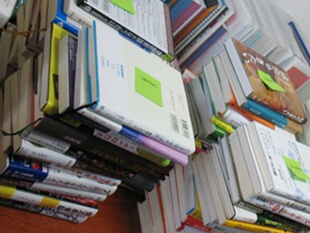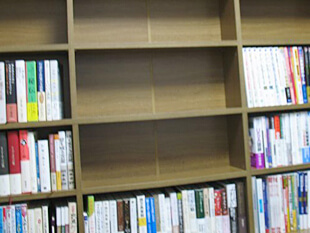No More Frustration – Five Basic Steps for a Neat Bookcase
The last two times, we discussed common concerns about bookshelves as well as some solutions and how to snap out of being unable to throw books away.
For those who have finally decided to rearrange their bookshelves, we now explain some basic steps to sort out your books without getting discouraged halfway through. Some of this is a review of previous tips, but we hope you’ll find it a useful reference.
Step 1 Gather all your books in one place.
This is a storage technique not only for books. Even if you store your books in more than one room, put them together in one place first. This lets you see clearly how many books you have. You may not think you have such a lot, but putting them all together could surprise you.
Step 2 Categorize your books by genre.
This requires patience if you own a lot of books, but it‘s an important task to face yourself so don’t skip it. First of all divide them into broad categories such as “business,” “novels,” etc.
If there are many books in one category, divide them further into sub-categories. Business books, for example, could be categorized under business etiquette, marketing, sales, investment, management, leadership, industry information, and so on. And cookery books could be grouped according to chefs or food genres such as desserts, healthy food, etc. With novels, it’s best to arrange them by author.
The categories containing the most books are in the fields that you are (or have been) most interested in. If you have some similar or even identical books, this is when you’ll realize it.
We also recommend that you create a separate category of books you haven’t read yet.
Step 3 Categorize your books as “needed” or “not needed.”
Sort your books according to whether you really need them or not. You won’t make any progress with this if you open any of them and start reading, so make your decisions based on their covers only. If you can’t remember what’s in a book by reading its cover, or if you don’t even remembering owning it, put it in the “not needed” category. If you’re unsure how to decide whether you need a book, start by looking for details that enable you to make an objective decision.
The easiest method to understand is considering books that include a date, such as “2010 edition.” This applies to books related to qualifications, for instance. If you’re studying for a qualification, the latest edition of a book is the most helpful and you don’t need any previous editions.
It’s also easy to identify books that you no longer need due to a change in your living circumstances, such as a career change or job transfer, a wedding or the birth of a child.
Books about your current hobbies and books that are keepsakes are the most difficult to assess, so leave them until last. The task of deciding which books you do or don’t need will go more smoothly if you can get into a kind of rhythm.
Also, don’t automatically think that you need all your unread books. Think whether you actually need each one.
When it comes to books that you’ve enjoyed reading, you yourself will know whether you want to keep them or not, so these decisions should be quick. When all the books you own are ones that you have enjoyed, just looking at your bookshelves will give you pleasure.

Step 4 Return your books to the shelves.
Put the books back on the shelves in their categories, positioning books on subjects that are of particular interest to you where they can be seen most easily. You can also put unread books on more visible shelves so that you don’t forget to read them.
Keeping lighter books such as paperbacks on the upper shelves and heavier, larger volumes on the lower shelves is safer and looks better too.
Depending on your lifestyle and how much storage space you have, you may separate your books into more than one place. In that case, keeping all the books of each genre together, such as cookery books in the kitchen, picture books in the bedroom, and so on, makes it easier to return them after reading.
On deeper shelves, you may feel like putting photos or ornaments in front of the books, but try to keep this to a minimum because it makes it harder to take books out.
To keep enough room for adding new books, it’s best to fill your bookshelves to about 70% or 80% of their capacity. You may not have enough room to keep certain books that you need for work or a valuable book collection that you don’t want to let go, in which case you could keep them in a trunk room. Such facilities are fully air-conditioned so your valuable books would be protected from humidity.

Step 5 Attach index labels.
Another storage technique that is often mentioned, again not only for books, is attaching index labels to make it easier to find the books you want and to keep your bookshelves clean and tidy.
Methods include sticking labels directly onto shelves or sliding labeled cards between books, but we recommend fixing index labels to DVD cases, which can then be arranged on the shelves alongside your books. This method will let you reorganize your books easily in future, and is less likely to cause you stress because the index labels will not fall out easily. Empty DVD cases can be purchased at 100-yen shops so do try using them.
Well, what about it? This job may take longer than you think. But after it’s finished, your bookcases will look neater than you expected, and you will feel better too.
The beginning of the new business year is a good time to reorganize your bookshelves, so do try it on your next day off.
Text: Shipshape Bookcase Institute (Hondana Sukkiri Kenkyujo), Hiroyuki Shimada
[Profile Hiroyuki Shimada]
Launched an online used bookstore after working for Yahoo! and Amazon Japan. Currently launching the Shipshape Bookcase Institute (Hondana Sukkiri Kenkyujo) together with his wife to offer a bookcase organizing and book disposal onsite service. They provide advice on bookcase organizing and storage from the perspectives of both men and women. They have earned favorable reviews from customers, who note that, “Once I got my bookcase organized, I felt organized as well.” They aim to create a living bookcase that can be used every day.
URL:http://www.hondana-sukkiri.com/